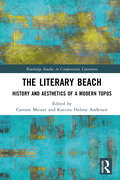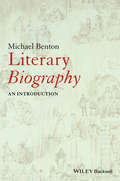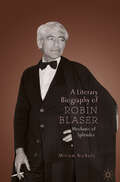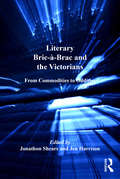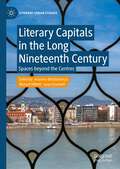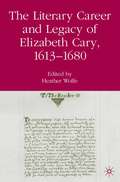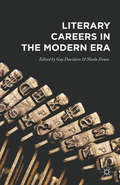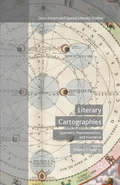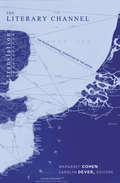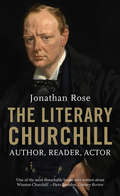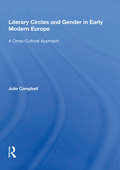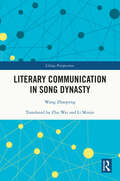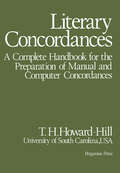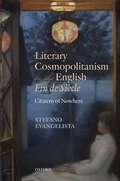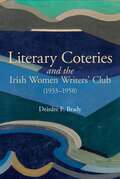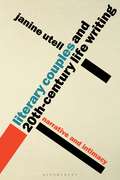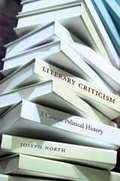- Table View
- List View
The Literary Beach: History and Aesthetics of a Modern Topos (Routledge Studies in Comparative Literature)
by Carsten Meiner Katrine Helene AndersenAs a geo-historical place, the beach integrates a variety of characteristics and functions so multiple that they tend to contradict each other. The beach is both a place of work and trade but also of leisure; it is both a place of therapy and health but also of migration, war, and death; it is a place of mass tourism and boredom but also the place of experiencing the Other; it is a public place but also an uncivilized and desolate place.This book studies the literary representation of the beach from ancient Greek literature up until today, drawing on English, French, Italian, American, and Spanish literatures from various periods and genres and presenting multiple ways of comparing and understanding literary beaches as a ubiquitous literary phenomenon. It demonstrates how the literary beach as a both geo-historical place and as an aesthetic literary commonplace has been a constant and privileged resource for the analysis of more general existential, sociological, and moral problems. This is the case when for instance the Tahitian beach becomes the place of the "already modern" in Stevenson's tales, or when the Italian beach becomes a question of modern feminism in Ferrante.In this sense, literature expands the local or national beach by articulating its transnational complexities.
The Literary Beach: History and Aesthetics of a Modern Topos (Routledge Studies in Comparative Literature)
As a geo-historical place, the beach integrates a variety of characteristics and functions so multiple that they tend to contradict each other. The beach is both a place of work and trade but also of leisure; it is both a place of therapy and health but also of migration, war, and death; it is a place of mass tourism and boredom but also the place of experiencing the Other; it is a public place but also an uncivilized and desolate place.This book studies the literary representation of the beach from ancient Greek literature up until today, drawing on English, French, Italian, American, and Spanish literatures from various periods and genres and presenting multiple ways of comparing and understanding literary beaches as a ubiquitous literary phenomenon. It demonstrates how the literary beach as a both geo-historical place and as an aesthetic literary commonplace has been a constant and privileged resource for the analysis of more general existential, sociological, and moral problems. This is the case when for instance the Tahitian beach becomes the place of the "already modern" in Stevenson's tales, or when the Italian beach becomes a question of modern feminism in Ferrante.In this sense, literature expands the local or national beach by articulating its transnational complexities.
Literary Biography: An Introduction
by Michael BentonLiterary Biography: An Introduction illustrates and accounts for the literary genre that merges historical facts with the conventions of narrative while revealing how the biographical context can enrich the study of canonical authors. Provides up-to-date and comprehensive coverage of issues and controversies in life writing, a rapidly growing field of study Offers a valuable biographical and historical context for the study of major classic and contemporary authors Features an interview with Wilfred Owen's biographer, Dominic Hibberd; a gallery of literary portraits with commentaries; close readings that illustrate the differences between fiction and biography; speculation about likely future developments; and detailed suggestions for further reading
Literary Biography: An Introduction
by Michael J. BentonLiterary Biography: An Introduction illustrates and accounts for the literary genre that merges historical facts with the conventions of narrative while revealing how the biographical context can enrich the study of canonical authors. Provides up-to-date and comprehensive coverage of issues and controversies in life writing, a rapidly growing field of study Offers a valuable biographical and historical context for the study of major classic and contemporary authors Features an interview with Wilfred Owen's biographer, Dominic Hibberd; a gallery of literary portraits with commentaries; close readings that illustrate the differences between fiction and biography; speculation about likely future developments; and detailed suggestions for further reading
A Literary Biography of Robin Blaser: Mechanic of Splendor (Modern and Contemporary Poetry and Poetics)
by Miriam NicholsA Literary Biography of Robin Blaser: Mechanic of Splendor is the first major study illustrating Robin Blaser’s significance to North American poetry. The poet Robin Blaser (1925–2009) was an important participant in the Berkeley Renaissance of the 1950s and San Francisco poetry circles of the 1960s. The book illuminates Blaser’s distinctive responses to and relationships with familiar writers including Robert Duncan, Jack Spicer, and Charles Olson via their correspondence. Blaser contributed to the formation of the serial poem as a dominant mode in post-war New American poetry through his work and engagement with the poetry communities of the time. Offering a new perspective on a well-known and influential period in American poetry, Miriam Nichols combines the story of Blaser’s life—coming from a mid-western conservative religious upbringing and his coming of age as a gay man in Berkeley, Boston, and San Francisco—with critical assessments of his major poems through unprecedented archival research. This literary biography presents Blaser’s poetry and poetics in the many contexts from which it came, ranging from the Berkeley Renaissance to the Vancouver scene; from surrealism to phenomenology; from the New American poetry to the Canadian postmodern; from the homoerotic to high theory. Throughout, Blaser’s voice is heard in the excitement of his early years in Berkeley and Boston and the seriousness of the later years where he was doing most of his living in his work.
Literary Bric-à-Brac and the Victorians: From Commodities to Oddities (The Nineteenth Century Series)
by Jen HarrisonWhat are we to make of the Victorians’ fascination with collecting? What effect did their encounters with the curious, exotic and downright odd have on Victorian writers and their works? The essays in this collection take up these questions by examining the phenomenon of bric-Ã -brac in Victorian literature. The contributors to Literary Bric-Ã -Brac and the Victorians: From Commodities to Oddities explore sites of unusual concurrence (including museums, the home, art galleries, private collections) and the way in which bric-Ã -brac brought the alien into everyday settings, the past into the present and the wild into the domestic. Focusing on the representation of material culture in Victorian literature, the essays in this volume seek out miscellaneous and incongruous objects that take readers beyond the commonplace paradigms associated with commodity culture. Individual chapters analyse the work of writers as different as Edward Lear and John Henry Newman, Robert Browning and George Eliot, Charles Dickens and Lewis Carroll. In so doing they shed light on a dizzying array of topics and objects that include class and capitalism, the occult and the sacraments, Darwinism and dandyism, umbrellas, textiles, the Philosopher’s Stone and even the household nail.
Literary Bric-à-Brac and the Victorians: From Commodities to Oddities (The Nineteenth Century Series)
by Jen HarrisonWhat are we to make of the Victorians’ fascination with collecting? What effect did their encounters with the curious, exotic and downright odd have on Victorian writers and their works? The essays in this collection take up these questions by examining the phenomenon of bric-Ã -brac in Victorian literature. The contributors to Literary Bric-Ã -Brac and the Victorians: From Commodities to Oddities explore sites of unusual concurrence (including museums, the home, art galleries, private collections) and the way in which bric-Ã -brac brought the alien into everyday settings, the past into the present and the wild into the domestic. Focusing on the representation of material culture in Victorian literature, the essays in this volume seek out miscellaneous and incongruous objects that take readers beyond the commonplace paradigms associated with commodity culture. Individual chapters analyse the work of writers as different as Edward Lear and John Henry Newman, Robert Browning and George Eliot, Charles Dickens and Lewis Carroll. In so doing they shed light on a dizzying array of topics and objects that include class and capitalism, the occult and the sacraments, Darwinism and dandyism, umbrellas, textiles, the Philosopher’s Stone and even the household nail.
Literary Capitals in the Long Nineteenth Century: Spaces beyond the Centres (Literary Urban Studies)
by Richard Hibbitt Arunima Bhattacharya Laura ScuriattiThis book develops our understanding of the global literary field in the long nineteenth century by discussing nine different places outside the established metropoles. It shows how different economic, geographical and political factors combined to give each place its own distinctive literary culture and symbolic capital. Taking a geocritical approach, the book shows how its different case studies can be seen as ‘literary capitals’ in terms of their role within the wider nation, region or empire. The volume is divided into three parts. Part One discusses Kolkata, Hong Kong and Buenos Aires. Part Two considers ‘semi-peripheral’ European cities: Pest-Buda (Budapest), Helsinki and Dublin. Part Three focuses on cities within Italy: Trieste, Florence and Rome. Drawing on a wide range of literary texts and different genres, the book reads the nineteenth-century literary field as a constellation where different connections can be plotted across various points on the map at different times.
The Literary Career and Legacy of Elizabeth Cary, 1613-1680
by H. WolfeThis is the first book to study the work and influence of Elizabeth Cary, author of the first original play by a woman to be printed in English, The Tragedyie of Mariam (1613). Previous criticism focused concentrated on this and The History of Edward II , this volume incorporates critical and historical analyses of other genres too.
Literary Careers in the Modern Era
by Guy Davidson Nicola EvansThis is the first study of the shape and diversity of the literary career in the 20th and 21st centuries. Bringing together essays on a wide range of authors from Australia, Canada, the United States and the United Kingdom, the book investigates how literary careers are made and unmade, and how norms of authorship are shifting in the digital era.
Literary Cartographies: Spatiality, Representation, and Narrative (Geocriticism and Spatial Literary Studies)
by Robert T. Tally Jr.Exploring narrative mapping in a wide range of literary works, ranging from medieval romance to postmodern science fiction, this volume argues for the significance of spatiality in comparative literary studies. Contributors demonstrate how a variety of narratives represent the changing social spaces of their world.
The Literary Channel: The Inter-National Invention of the Novel
by Margaret Cohen Carolyn DeverThe Literary Channel defines a crucial transnational literary "zone" that shaped the development of the modern novel. During the first two centuries of the genre's history, Britain and France were locked in political, economic, and military struggle. The period also saw British and French writers, critics, and readers enthusiastically exchanging works, codes, and theories of the novel. Building on both nationally based literary history and comparatist work on poetics, this book rethinks the genre's evolution as marking the power and limits of modern cultural nationalism. In the Channel zone, the novel developed through interactions among texts, readers, writers, and translators that inextricably linked national literary cultures. It served as a forum to promote and critique nationalist clichés, whether from the standpoint of Enlightenment cosmopolitanism, the insurgent nationalism of colonized spaces, or the non-nationalized culture of consumption. In the process, the Channel zone promoted codes that became the genre's hallmarks, including the sentimental poetics that would shape fiction through the nineteenth century. Uniting leading critics who bridge literary history and theory, The Literary Channel will appeal to all readers attentive to the future of literary studies, as well as those interested in the novel's development, British and French cultural history, and extra-national patterns of cultural exchange. Contributors include April Alliston, Emily Apter, Margaret Cohen, Joan DeJean, Carolyn Dever, Lynn Festa, Françoise Lionnet, Deidre Shauna Lynch, Sharon Marcus, Richard Maxwell, and Mary Helen McMurran.
The Literary Channel: The Inter-National Invention of the Novel
by Margaret Cohen Carolyn DeverThe Literary Channel defines a crucial transnational literary "zone" that shaped the development of the modern novel. During the first two centuries of the genre's history, Britain and France were locked in political, economic, and military struggle. The period also saw British and French writers, critics, and readers enthusiastically exchanging works, codes, and theories of the novel. Building on both nationally based literary history and comparatist work on poetics, this book rethinks the genre's evolution as marking the power and limits of modern cultural nationalism. In the Channel zone, the novel developed through interactions among texts, readers, writers, and translators that inextricably linked national literary cultures. It served as a forum to promote and critique nationalist clichés, whether from the standpoint of Enlightenment cosmopolitanism, the insurgent nationalism of colonized spaces, or the non-nationalized culture of consumption. In the process, the Channel zone promoted codes that became the genre's hallmarks, including the sentimental poetics that would shape fiction through the nineteenth century. Uniting leading critics who bridge literary history and theory, The Literary Channel will appeal to all readers attentive to the future of literary studies, as well as those interested in the novel's development, British and French cultural history, and extra-national patterns of cultural exchange. Contributors include April Alliston, Emily Apter, Margaret Cohen, Joan DeJean, Carolyn Dever, Lynn Festa, Françoise Lionnet, Deidre Shauna Lynch, Sharon Marcus, Richard Maxwell, and Mary Helen McMurran.
The Literary Churchill: Author, Reader, Actor
by Jonathan RoseThis strikingly original book introduces a Winston Churchill we have not known before. Award-winning author Jonathan Rose explores in tandem Churchill’s careers as statesman and author, revealing the profound influence of literature and theater on Churchill’s personal, carefully composed grand story and on the decisions he made throughout his political life. Rose provides in this expansive literary biography an analysis of Churchill’s writings and their reception (he won the Nobel Prize for Literature in 1953 and was a best-selling author), and a chronicle of his dealings with publishers, editors, literary agents, and censors. The book also identifies an array of authors who shaped Churchill’s own writings and politics: George Bernard Shaw, H. G. Wells, Margaret Mitchell, George Orwell, Oscar Wilde, and many more. Rose investigates the effect of Churchill’s passion for theater on his approach to reportage, memoirs, and historical works. Perhaps most remarkably, Rose reveals the unmistakable influence of Churchill’s reading on every important episode of his public life, including his championship of social reform, plans for the Gallipoli invasion, command during the Blitz, crusade for Zionism, and efforts to prevent a nuclear arms race. In a fascinating conclusion, Rose traces the significance of Churchill’s writings to later generations of politicians, among them President John F. Kennedy as he struggled to extricate the U.S. from the Cuban Missile Crisis.
Literary Circles and Gender in Early Modern Europe: A Cross-Cultural Approach
by Julie CampbellA comparative analysis, this study examines the interactions of early modern male and female writers within the context of literary circles. In particular, Campbell examines how the querelle des femmes as a discursive rhetorical tradition of praise and blame influenced perceptions of well-educated women who were part of literary circles in Italy, France, and England from approximately 1530 to 1650. To gain a better sense of how querelle language and issues were used for or against learned women writers, Campbell aligns selected works by female and male writers, pairing them to analyze how the woman writer responds, deflects, or rewrites the male writer's ideological script on women. She focuses first on the courtesan Tullia d'Aragona's response in her Dialogo della infinità di amore to Sperone Speroni's Dialogo di amore, and contrasts the actress/writer Isabella Andreini's pastoral La Mirtilla with Torquato Tasso's Aminta. She then discusses the influence of Italian actresses upon the manners and mores of French women of the Valois court, especially focusing on performative aspects of French women's participation in court and salon rituals. To that end, she examines the influential salon of the aristocratic, learned Claude-Catherine de Clermont, duchesse de Retz, who encouraged the writing of positive querelle rhetoric in the form of Petrarchan, Neoplatonic encomiastic poetry to buttress her reputation and that of her female friends. Next, Campbell reads Louise Lab D‘t de Folie et d'Amour against Pontus de Tyard's Solitaire premier to illustrate the tensions between a traditional and nontraditional querelle stance. She then discusses Continental influence upon English writers in the context of the Sidney circle in England. Moving to the closet dramas of the Sidney circle, Campbell examines the solidarity these writers demonstrated with nontraditional stances on querelle issues, and, finally, she explores how three generations of English literary circles con
Literary Circles and Gender in Early Modern Europe: A Cross-Cultural Approach
by Julie CampbellA comparative analysis, this study examines the interactions of early modern male and female writers within the context of literary circles. In particular, Campbell examines how the querelle des femmes as a discursive rhetorical tradition of praise and blame influenced perceptions of well-educated women who were part of literary circles in Italy, France, and England from approximately 1530 to 1650. To gain a better sense of how querelle language and issues were used for or against learned women writers, Campbell aligns selected works by female and male writers, pairing them to analyze how the woman writer responds, deflects, or rewrites the male writer's ideological script on women. She focuses first on the courtesan Tullia d'Aragona's response in her Dialogo della infinità di amore to Sperone Speroni's Dialogo di amore, and contrasts the actress/writer Isabella Andreini's pastoral La Mirtilla with Torquato Tasso's Aminta. She then discusses the influence of Italian actresses upon the manners and mores of French women of the Valois court, especially focusing on performative aspects of French women's participation in court and salon rituals. To that end, she examines the influential salon of the aristocratic, learned Claude-Catherine de Clermont, duchesse de Retz, who encouraged the writing of positive querelle rhetoric in the form of Petrarchan, Neoplatonic encomiastic poetry to buttress her reputation and that of her female friends. Next, Campbell reads Louise Lab D‘t de Folie et d'Amour against Pontus de Tyard's Solitaire premier to illustrate the tensions between a traditional and nontraditional querelle stance. She then discusses Continental influence upon English writers in the context of the Sidney circle in England. Moving to the closet dramas of the Sidney circle, Campbell examines the solidarity these writers demonstrated with nontraditional stances on querelle issues, and, finally, she explores how three generations of English literary circles con
Literary Communication in Song Dynasty (ISSN)
by Wang ZhaopengBased on first-hand historical materials, this book explores the various aspects of literary communication during the Song Dynasty in China.The book investigates the single-channel dissemination of poetry and ci works, the dissemination of literary collections, the dissemination through wall inscriptions, the oral dissemination of Song ci, the remuneration and commercialization of literature in the Song Dynasty, the paths to fame for Song writers, the non-literary factors in the dissemination of literature and the dissemination of literary works through paintings and songs. The author provides insights into the six major questions in the study of literary communication: Who disseminates, where, how, what, to whom and the effects of dissemination. The author also seeks to provide detailed answers to the following questions. What was the role of female singers in both domestic and official entertainment? What were the costs and prices of the books? Who paid the authors? What methods did writers use to gain fame and social recognition?This work will be essential reading for scholars and students of Chinese studies, communication studies and media and cultural studies.
Literary Communication in Song Dynasty (ISSN)
by Wang ZhaopengBased on first-hand historical materials, this book explores the various aspects of literary communication during the Song Dynasty in China.The book investigates the single-channel dissemination of poetry and ci works, the dissemination of literary collections, the dissemination through wall inscriptions, the oral dissemination of Song ci, the remuneration and commercialization of literature in the Song Dynasty, the paths to fame for Song writers, the non-literary factors in the dissemination of literature and the dissemination of literary works through paintings and songs. The author provides insights into the six major questions in the study of literary communication: Who disseminates, where, how, what, to whom and the effects of dissemination. The author also seeks to provide detailed answers to the following questions. What was the role of female singers in both domestic and official entertainment? What were the costs and prices of the books? Who paid the authors? What methods did writers use to gain fame and social recognition?This work will be essential reading for scholars and students of Chinese studies, communication studies and media and cultural studies.
Literary Concordances: A Complete Handbook for the Preparation of Manual and Computer Concordances
by T. H. Howard-HillAll problems likely to be encountered by anyone who intends to prepare a literary concordance are discussed on a practical level, although there is substantial examination of more advanced concording techniques which the computer makes it possible to adopt. Although the emphasis is on works in English, the structural principles which are analysed in the book can be applied readily to works in other languages
Literary Cosmopolitanism in the English Fin de Siècle: Citizens of Nowhere
by Stefano EvangelistaThe fin de siècle witnessed an extensive and heated debate about cosmopolitanism, which transformed readers' attitudes towards national identity, foreign literatures, translation, and the idea of world literature. Focussing on literature written in English, Literary Cosmopolitanism in the English Fin de Siècle offers a critical examination of cosmopolitanism as a distinctive feature of the literary modernity of this important period of transition. No longer conceived purely as an abstract philosophical ideal, cosmopolitanism—or world citizenship—informed the actual, living practices of authors and readers who sought new ways of relating local and global identities in an increasingly interconnected world. The book presents literary cosmopolitanism as a field of debate and controversy. While some writers and readers embraced the creative, imaginative, emotional, and political potentials of world citizenship, hostile critics denounced it as a politically and morally suspect ideal, and stressed instead the responsibilities of literature towards the nation. In this age of empire and rising nationalism, world citizenship came to enshrine a paradox: it simultaneously connoted positions of privilege and marginality, connectivity and non-belonging. Chapters on Oscar Wilde, Lafcadio Hearn, George Egerton, the periodical press, and artificial languages bring to light the variety of literary responses to the idea of world citizenship that proliferated at the turn of the twentieth century. The book interrogates cosmopolitanism as a liberal ideology that celebrates human diversity and as a social identity linked to worldliness; it investigates its effect on gender, ethics, and the emotions. It presents the literature of the fin de siècle as a dynamic space of exchange and mediation, and argues that our own approach to literary studies should become less national in focus.
Literary Cosmopolitanism in the English Fin de Siècle: Citizens of Nowhere
by Stefano EvangelistaThe fin de siècle witnessed an extensive and heated debate about cosmopolitanism, which transformed readers' attitudes towards national identity, foreign literatures, translation, and the idea of world literature. Focussing on literature written in English, Literary Cosmopolitanism in the English Fin de Siècle offers a critical examination of cosmopolitanism as a distinctive feature of the literary modernity of this important period of transition. No longer conceived purely as an abstract philosophical ideal, cosmopolitanism—or world citizenship—informed the actual, living practices of authors and readers who sought new ways of relating local and global identities in an increasingly interconnected world. The book presents literary cosmopolitanism as a field of debate and controversy. While some writers and readers embraced the creative, imaginative, emotional, and political potentials of world citizenship, hostile critics denounced it as a politically and morally suspect ideal, and stressed instead the responsibilities of literature towards the nation. In this age of empire and rising nationalism, world citizenship came to enshrine a paradox: it simultaneously connoted positions of privilege and marginality, connectivity and non-belonging. Chapters on Oscar Wilde, Lafcadio Hearn, George Egerton, the periodical press, and artificial languages bring to light the variety of literary responses to the idea of world citizenship that proliferated at the turn of the twentieth century. The book interrogates cosmopolitanism as a liberal ideology that celebrates human diversity and as a social identity linked to worldliness; it investigates its effect on gender, ethics, and the emotions. It presents the literature of the fin de siècle as a dynamic space of exchange and mediation, and argues that our own approach to literary studies should become less national in focus.
Literary Coteries and the Irish Women Writers' Club (Liverpool English Texts and Studies #87)
by Deirdre F. BradyAs publishers in private printing presses, as writers of dissident texts and as political campaigners against censorship and for intellectual freedom, a radical group of twentieth-century Irish women formed a female-only coterie to foster women’s writing and maintain a public space for professional writers. This book documents the activities of the Women Writers’ Club (1933–1958), exploring its ethos, social and political struggles, and the body of works created and celebrated by its members. Examining the period through a history of the book approach, it covers social events, reading committees, literary prizes, publishing histories, modernist printing presses, book fairs, reading practices, and the various political philosophies shared by members of the Club. It reveals how professional women writers deployed their networks and influence to carve out a space for their writing in the cultural marketplace, collaborating with other artistic groups to fight for creative freedoms and the right to earn a living by the pen. The book paints a vivid portrait of the Women Writers’ Club, showcasing their achievements and challenging existing orthodoxy on the role of women in Irish literary life.
Literary Couples and 20th-Century Life Writing: Narrative and Intimacy
by Janine UtellExposing how modernist and late-modernist writers tell the stories of their intimate relationships though life writing, this book engages with the process by which these authors become subjects to a significant other, a change that subsequently becomes narrative within their works. Looking specifically at partners in a couple, Janine Utell focuses on such literary pairings as Virginia and Leonard Woolf, Gertrude Stein and Alice B. Toklas, Sylvia Townsend Warner and Valentine Ackland, Christopher Isherwood and Don Bachardy, and Sylvia Plath and Ted Hughes. Utell draws on the latest work in narrative theory and the study of intimacy and affects to shed light on the ethics of reading relationships in the modern period. Focusing on a range of genres and media, from memoir through documentary film to comics, this book demonstrates that stories are essential for our thinking of love, desire and sexuality.
Literary Couples and 20th-Century Life Writing: Narrative and Intimacy
by Janine UtellExposing how modernist and late-modernist writers tell the stories of their intimate relationships though life writing, this book engages with the process by which these authors become subjects to a significant other, a change that subsequently becomes narrative within their works. Looking specifically at partners in a couple, Janine Utell focuses on such literary pairings as Virginia and Leonard Woolf, Gertrude Stein and Alice B. Toklas, Sylvia Townsend Warner and Valentine Ackland, Christopher Isherwood and Don Bachardy, and Sylvia Plath and Ted Hughes. Utell draws on the latest work in narrative theory and the study of intimacy and affects to shed light on the ethics of reading relationships in the modern period. Focusing on a range of genres and media, from memoir through documentary film to comics, this book demonstrates that stories are essential for our thinking of love, desire and sexuality.
Literary Criticism: A Concise Political History
by Joseph NorthSince the global turn to neoliberalism in the 1970s, movements in literary studies have been diagnostic rather than interventionist: scholars have developed techniques for analyzing culture but have retreated from attempts to transform it. For Joseph North, a genuinely interventionist criticism is a central task facing scholars on the Left today.
